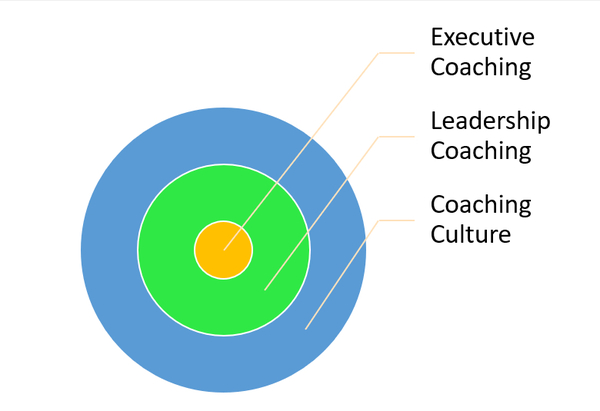THE WORLD’S #1 EXECUTIVE COACHING AND BUSINESS COACHING BLOG SINCE 2017.
Comprehensive Guide to Coaching in Business
December 7, 2018 | Category: Blog, Executive Coaching
The concept of coaching can be considered from countless different angles, and what the process actually involves may vary significantly from case to case.
Whatever the context, coaching is about helping people improve their performance.
Verbs associated with the umbrella term “coaching” include:
- Instruct
- Tutor
- Teach
- Train
- Educate
- Prepare
- Mentor
- Direct
and many more. And yet, none of those terms is exactly synonymous with coaching. If you’ve ever witnessed a good coach in action, you have probably seen many of those verbs being demonstrated. Coaches may educate as to why the team uses the shotgun formation, or they may prepare by sharing statistics about an opposing team. A coach may help train her client to access or strengthen parts of her vocal register, or mentor someone younger so they’re better prepared for challenges.
Coaching in business is analogous to coaching in sports, music, dialect, or other endeavors, in that it involves a custom blend of techniques and exercises that are ultimately designed to improve performance in ways that can be measured. The very popularity of the concept of coaching, unfortunately, has led to people offering executive coaching services despite lack of experience, because many businesses are hungry for the important services coaches provide. It’s important to understand how coaching in business works, and also how it doesn’t work.
History of Coaching in General and Coaching in Business
If you trace the history of the term “coaching,” you find that it, naturally, comes from the word “coach,” which originally referred to the kind of four-wheeled, covered carriage designed to get people from point A to point B. Modern coaching, in many ways, is a type of conveyance, because it is designed to help clients get from where they are now to a place where they perform better.
Use of the term “coach” in the sense of an “instructor” or “trainer” dates to the early 19th century when it was a slang term used by Oxford University students who worked with private tutors. Coaching as a sports term dates to around 1860.
So you see, “coaching,” though we tend to think of it primarily in athletic contexts, actually started out in an academic context, so it’s not that big a stretch to think of coaching as being absolutely fitting in a business context. It wasn’t until the 1970s, however, that companies in the United States began to realize the amazing potential of coaching in business, because of its combination of one-on-one conversation and its focus on measurable performance.
How Coaching Works in Theory
The coach-client relationship is more egalitarian than the teacher-pupil relationship. Solution and goal-attainment are the goals in both the coach-client relationship and the teacher-pupil relationship, but how those goals are achieved differ. The executive or corporate leader doesn’t need to be trained in how to do their job, but quite often they could benefit from learning new and different ways to perform better, deal with challenges, and help the organization as a whole work better.
Coaching is designed to use positive resources like optimism and resilience. If you ever had a great coach when playing sports as a child, you probably remember that coach because of their gift for simultaneous correction and encouragement. A great coach will show you not only how to hold the bat correctly, but why you’ll get better results that way. And then when you get that first strong hit using your newly learned technique, your coach will be the first one to cheer you on.
The same is true with coaching in business. Coaches aren’t there to coddle executives, but to help them recognize gaps in their performance, develop ways to bridge those gaps, and offer encouragement when new and effective techniques are learned and demonstrated.
How Coaching Works in Practice
After an initial intake session, coaching interactions may take place in person, or by other communication means like phone calls or video chat.
Assuming a coach has been employed based on their qualifications and “good fit” with the client, the process typically starts out with an “intake” session where coach and client get to know each other. For the coach, this often means using various standardized assessments designed to elicit information critical to defining strengths and weaknesses and setting reasonable goals. While the intake meeting may be similar for most of a coach’s clients, the subsequent coaching sessions are more personalized.
In general, however, the practice of coaching involves the following steps:
- Determining which issues limit the client’s ability to perform at an optimum level
- Determining how to address those issues
- Discussing potential solutions or improvement actions for the client, with input from the client
- Developing a written action plan listing what the client, coach (and possibly other stakeholders, such as the client’s manager) will do to improve performance
- Set dates and times for follow-up interactions
- During follow-up interactions, further exercises and “homework” may be assigned to encourage further progress toward goals
Coaching in Business for Executives
Why would a CEO, someone at the pinnacle of an organization, need a coach? For the same reason that Usain Bolt, the fastest man in the world, needs a coach: to maintain form and continue peak performance over the long term.
Likewise, other senior executives, who may act with a great deal of autonomy, benefit from coaching as well. Coaches help executives recognize their blind spots, and the invisible barriers they may have built around themselves as they climbed the corporate ladder. Psychological blind spots may soothe the ego, but they’re otherwise detrimental in the long term.
Coaches act dispassionately, and this can be eye-opening for a top executive who is used to having their every opinion rubber-stamped by others. The value of an unbiased perspective cannot be overemphasized when it comes to corporate leadership. Consequently, a coach is often willing to ask questions that others wouldn’t feel they had the authority to ask. Because a strong coaching relationship is egalitarian, the coach has the opportunity to relate to an executive on a level that no one else does, and this can open up an entirely new perspective for the client.
Coaching in Business for Other Leaders
It’s not uncommon for businesses to engage coaches to work with non-executive leaders, and there are many reasons for this. The main reason is that coaching improves performance, and why wouldn’t a business want all leaders to perform at peak levels? Another reason non-executive leaders work with coaches is that top leadership is committed to strong leadership succession. Eventually, executives retire or move on, and having a strong “bench” of potential executives makes these transitions less disruptive.
Also, depending on the company size and structure, non-executive leaders, such as department heads, may have significant autonomy and significant influence over day-to-day operations as well as results like productivity and profitability. In those cases, it only makes sense that the leaders entrusted with presiding over departments or key teams have all the skills and resources they need at their disposal, so they can generate peak performance from their departments or teams.
Using Coaching Principles Throughout an Organization
Coaching culture as exemplified and encouraged by those at top levels of the organization ripples outward throughout the organization.
Most companies don’t have the resources to engage coaches for all their personnel in leadership positions, but that doesn’t mean that coaching in business is reserved solely for those at the very top of the organizational chart. The value of a coaching culture at every level of business has been demonstrated repeatedly.
Coaching-based leadership makes sense not only for the CEO or the vice president for financial operations, but also for the administrative team leader, the head line cook, and the leader of the facilities management team.
The fact is, “traditional” leadership, which is often based on control and correction, may work well in the short term, but falls short over time. Coaching-based leadership is based on asking questions that spark insight, listening, and re-framing challenges as opportunities. This approach to leadership works whether you’re getting a team ready to orchestrate a merger, directing a group of summer interns, or heading the team in charge of implementing new accounting software.
The best way top brass can instill a coaching culture (aside from using coaches with as many leaders as is feasible) is to lead by example. Other ways include:
- Asking questions and showing that it’s OK for everyone to ask questions
- Encouraging self-coaching among team members
- Listening to suggestions from frontline employees
- Tracking results of coaching culture efforts
- Offering training opportunities for people at all levels
What Businesses Want from Coaching
They want quantifiable results. Yes, coaching can be empowering and help leaders feel better about what they’re doing, but ultimately businesses want the value of coaching to be reflected on their bottom line. There are both highly competent coaches and ineffective coaches. While ineffective coaches waste time and money, outstanding coaches in business gain their reputation by helping businesses get measurable business results. Successful coaching engagements can result in:
- Increased sales performance
- Faster turnaround into profitability
- Better investor relationships
- Higher revenue
- Company growth
- Smoother leadership transitions
Businesses that hire executive coaches can calculate a simple benefits/cost ratio, dividing monetary benefits by the cost of the coaching. They can also calculate a return on coaching investment. Net benefits from coaching are the monetary benefits minus the coaching cost. Dividing the net benefits (earnings) by coaching cost (investment) and multiplying by 100 gives you an ROI percentage.
Another hard number that companies focus upon when engaging executive coaches is turnover (at all levels of the company). Employee turnover is expensive, and preventing the exodus of just a handful of professionals by improving operations and job satisfaction through coaching can more than offset coaching costs.
How Businesses Find Good Coaches
Due diligence in finding a good coach requires research, following up on recommendations, and confirming a candidate coach’s experience and qualifications.
Assuming the person designated to work with the coach is a ready and willing participant, the first step to finding the right coach is to look for someone with experience in coaching someone of that level – preferably in a similar industry. Choosing a coach with a clear methodology is paramount.
There is no single credential that indicates someone is an effective coach the way, say, someone with “M.D.” after their name is known to have completed medical school and passed various competency exams. But coaching credentials and accreditation of coach training programs exist.
The International Coach Federation (ICF) is a current “gold standard” for executive coaching. ICF-certified coaches are required to pursue rigorous education and practice standards before earning the credential, and this can help organizations separate effective, committed coaches from those who take coaching less seriously. Furthermore, coach training programs can gain accreditation by the ICF, assuring coach trainees that programs have high standards and deliver the training that aspiring coaches need.
Word-of-mouth recommendations are immensely valuable when it comes to coaches, and following up with references from candidate coaches is extremely important for businesses to ensure their resources are being spent wisely.
Matching the Coach to the Client
Good rapport, or “fit” between coach and client is essential to getting good results. The fact is, a coach may have sterling credentials, extensive experience, and glowing references, yet still be wrong for a particular client, even if the client is willing and motivated about being coached. It can be dangerous to assign a coach to a client without the two having at least had a conversation about it.
A client should feel inspired and confident from speaking with a coach. They should believe the coach is listening to them and truly considering what is said. Both coach and client should feel comfortable speaking honestly with each other, and each should understand the egalitarian relationship between coach and client. While both coach and client will take the lead at certain points during the term in which they work together, each should understand the other’s value and viewpoint at all times.
Clients and coaches who never feel as if they’re on the same page will have a hard time making progress. Likewise, clients and coaches who are too much alike risk complacency and simple validation, rather than genuinely uncovering goals and opportunities and working toward them. Ideally, a coaching client should talk to multiple coaches before choosing the one that represents the best fit for the process.
How a Company Can Implement Coaching
Companies that have never used coaching before will have to make a business case for it. This may start through a conversation among leaders, or with one leader researching coaching in business and learning how it works and how businesses benefit.
It’s not uncommon for businesses to experience pushback when they first bring up the idea of coaching. Some leaders may feel insulted, believing that hiring a coach indicates that they’re not performing well. Overcoming this type of resistance may be the most challenging aspect of implementing coaching for the first time.
It may end up that the person broaching the idea of bringing in coaches volunteers to be the first coaching client. This can help dispel the notion of coaching as “remedial” and help bring others on board with the idea. Any first-time coaching experience for a company should be thoroughly documented from beginning to end, not only so that others may learn what coaching really is about, but also to facilitate “lessons learned” and to make the next coaching engagement even better.
The person who initiates the idea of coaching may need to be willing to “go first” to gain buy-in from other leaders.
For coaching to gain traction in a business that has never used coaching before, leaders must understand that the old days of bringing in a coach to try to salvage a bad job appointment are long over with. There may have been a time when coaching in business was used to attempt remediation, but it didn’t take businesses long to realize that it’s not an effective use of coaching. Today, coaching in business is similar to coaching at the top levels of sport, or music: it’s designed to take the already highly competent to even greater levels of performance.
Conclusion
Coaching in business is no longer the rare exception, but is increasingly expected for CEOs, top executives, and other critical leadership positions. Coaching isn’t about teaching someone how to do their job – it’s assumed the client already knows that. It’s about making a leader’s inherent strengths stronger, and about recognizing where there’s opportunity for improvement and setting about making those improvements.
In an ideal world, everyone in a position of leadership would have the coaching they need, but it is entirely possible for a company to invest in coaching for top leadership and use the lessons learned as a way to bring coaching culture to all levels of the company.
In my career, I have consulted for more than 250 organizations and personally coached more than 200 executives. I have also been honored to receive many coaching and leadership training awards. The reason I’m so passionate about coaching in business is that I’ve personally seen what it can accomplish.
Glossary of Terms
Coaching – a partnership between a coach and a client in a creative, thought-provoking process that helps the client maximize their potential by defining, working toward, and achieving goals
Coaching culture – the culture within an organization where coaching is a key aspect of how leaders train, encourage, and engage followers, with the overall goal of increased personal and organizational performance
Corporate culture – the beliefs and behaviors that underly how employees interact with each other and with management, and how they handle business transactions and operations
Executive coaching – a coaching relationship designed specifically to help those at the top levels of organizational leadership maximize strengths, address shortcomings, and ultimately perform more effectively
Intake meeting – the initial meeting between a coach and client in which necessary preliminary tasks are taken care of, such as assessments, preliminary definitions of goals, and defining the scope and length of the coach-client relationship
International Coach Federation (ICF) – a leading global organization for advancing the coaching profession through certification, accreditation, and global networking of trained coaching professionals
Leadership coaching – a coaching relationship designed for leaders (who may or may not be executives), with the goals of maximizing strengths, addressing weaknesses, and performing leadership duties more effectively








